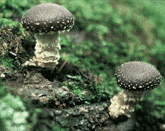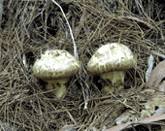- 글로벌메뉴
- KOREAN

 Korea Biodiversity Information System > Fungi/Lichen Resource > Resource Fungi > Edible Mushroom Resource
Korea Biodiversity Information System > Fungi/Lichen Resource > Resource Fungi > Edible Mushroom Resource
Hymenomycetes is one of the highest fungi. More specifically, it includes Jew’s ear, the fruit body of which is composed of collagen, Aphyllophorales composed of membranes, flesh, cork, and xylem, and Agaricales, which form gills and have a typical mushroom shape.
Most edible mushrooms belong to the Agaricales, and most medicinal mushrooms belong to the Aphyllophorales. Medicinal mushroom resources are included in the edible mushroom resources. About 14,000 species of mushrooms are known, and among these, about 7,000 species are known to be edible. In particular, about 60 species are cultivated commercially. Representative cultured mushrooms include shiitake, agaric, enoki, Agaricus bisporus and Pleurotus eryngii, and can be found easily in daily life. There are also a lot of non-cultivated edible mushrooms that are harvested from forests. These include Matsutake, Sarcodon aspratus, Amanita hemibapha, and Cantharellus cibarius, most of which are Mycorrhizal mushrooms.
Although cultivation of Shiitake started in China in 1000 A.D., in Korea, its cultivation officially started in the 1990s.
But seeing that Shiitake is found in documents of the Chosun Dynasty, it implies that our ancestors used it even before that time.
About 38,000 tons of this mushroom are currently produced, which is a large amount compared to Pleurotus ostreatus and Collybia velutipes.
Shiitake is known to taste better and have a higher pharmacologic effect than other edible mushrooms, so its popularity has risen in North America and Europe as well as in Korea.
It is predicted that by 2010, its production will reach the same level as that of Agaricus bisporus.


Although Tricholoma matsutake has been considered an important mushroom since ancient times, it became a major source of income for residents of mountain villages after its export to Japan in the late 1960s.
In Korea, Tricholoma matsutake can be found twice a year (in the summer and fall) in the pine forests on Taebaek Mountain and in Noryeongsanmaek and Charyeongsanmaek.
Other edible mushrooms include Pleurotus ostreatus, Collybia velutipes, Agaricus bisporus, Hypsizygus marmoreus, Pleurotus eryngii, Hericium erinaceus, Grifola frondosa, Auricularia auricula-judae, Volvariella volvacea, Pholiota adiposa, Sparassis crispa, Imbricated hydnum, Amanita hemibapha, Ramaria botrytis, and Amanita hemibapha.